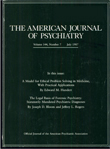Neurobiological mechanisms of panic anxiety: biochemical and behavioral correlates of yohimbine-induced panic attacks
Abstract
The effects of yohimbine, an alpha 2-adrenergic receptor antagonist, on anxiety, blood pressure, heart rate, and plasma levels of the norepinephrine metabolite 3-methoxy-4-hydroxyphenylglycol (MHPG) and cortisol were determined in 20 healthy subjects and 68 patients who had agoraphobia with panic attacks or panic disorder. Yohimbine produced panic attacks meeting DSM-III criteria in 37 patients and one healthy subject. The patients reporting yohimbine-induced panic attacks had significantly larger increases in plasma MHPG, cortisol, systolic blood pressure, and heart rate than the healthy subjects. These findings support the hypothesis relating high noradrenergic neuronal activity to the pathophysiology of panic attacks in a subgroup of panic disorder patients.
Access content
To read the fulltext, please use one of the options below to sign in or purchase access.- Personal login
- Institutional Login
- Sign in via OpenAthens
- Register for access
-
Please login/register if you wish to pair your device and check access availability.
Not a subscriber?
PsychiatryOnline subscription options offer access to the DSM-5 library, books, journals, CME, and patient resources. This all-in-one virtual library provides psychiatrists and mental health professionals with key resources for diagnosis, treatment, research, and professional development.
Need more help? PsychiatryOnline Customer Service may be reached by emailing [email protected] or by calling 800-368-5777 (in the U.S.) or 703-907-7322 (outside the U.S.).



